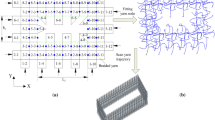Abstract
Based on the analysis of the movement rule of 3D five-way braided yarn, the 3D five-way braided case model is divided into three parts: base, case bottom plate and case wall. According to the characteristics of each part, the braiding and forming principle of a 3D five-way composite case was analyzed. Under the assumption of ignoring the influence of friction, bearing and other factors on the system, the differential equations of motion of the two-stage gear transmission system with case were established. The two-stage gear transmission system was numerically analyzed by Euler method, and the influence of dimensionless meshing frequency, clearance, case mass and damping on the dynamic characteristics of the transmission system was studied. After that, high and low frequency disturbance was applied to the input case. The research shows that the damping ratio of the composite case increases and the low frequency attenuation is accelerated due to the decrease of the case mass, so the composite case has better shock resistance to low frequency interference.
Similar content being viewed by others
References
C. L. Ma, J. M. Yang and T. W. Chou, Elastic stiffness of three-dimensional braided textile structure composites, Composite Materials: Testing and Design (1986) 404–421.
J. M. Yang, C. L. Ma and T. W. Chou, Fiber inclination model of three dimensional textile structural composites, J. of Composite Materials, 20 (5) (1986) 472–484.
Y. Q. Wang and A. S. D. Wang, Microstructure/property relationships in three dimensionally braided fiber composites, Composites Science and Technology, 53 (2) (1995) 213–222.
Y. Q. Wang and X. K. Sun, Digital-element simulation of textile processes, Composites Science and Technology, 61 (2) (2001) 311–319.
F. Y. Tong, X. F. Yao and X. H. Gao, Micro-mesoscopic prediction of void defect in 3D braided composites, Composites Part A Applied Science and Manufacturing, 147 (11) (2021) 106450.
L. Ge, H. Li and H. Zheng, Two-scale damage failure analysis of 3D braided composites considering pore defects, Composite Structures, 260 (23) (2021) 113556.
F. K. Ko and C. M. Pastore, Structure and properties of integrated 3-D fabric for structural composites, J. R. Vinson and M. Taya (Eds.), Recent Advances in Composites in the United States and Japan, American Society for Testing and Materials (1985) 428–439.
Y. Y. Miao, Zhou and Y. Q. Wang, Mechanics of textile composites: microgeometry, Composites Science and Technology, 68 (7) (2008) 1671–1678.
C. Zhang and X. W. Xu, Finite element analysis of 3D braided composites based on three unit-cells models, Composite Structures, 98 (11) (203) 130–142.
C. Zhang, Finite element analysis of the damage mechanism of 3D braided composites under high-velocity impact, J. of Materials Science, 52 (8) (2017) 1–17.
H. L. Zhou, W. Zhang and T. Liu, Finite element analyses on transverse impact behaviors of 3-D circular braided composite tubes with different braiding angles, Composites Part A Applied Science and Manufacturing, 79 (2015) 52–62.
W. Zhang, F. Zhang and X. Lan, Shape memory behavior and recovery force of 4D printed textile functional composites, Composites Science and Technology, 160 (4) (2018) 224–230.
L. Zhang, D. Hu and R. Wang, Establishing RVE model composed of dry fibers and matrix for 3D four-directional braided composites, J. of Composite Materials, 53 (14) (2018) 1917–1931.
F. C. Yang, X. J. Zhou and H. W. Hu, Nonlinear vibration characteristics of two-stage gear reducer, J. of Zhejiang University, 43 (2009) 1–7.
X. Wang, Y. X. Xu and B. L. Wu, Coupled nonlinear characteristic of a two-stage gear system with chipping fault, J. of Vibration and Shock, 35 (2016) 62–70.
G. Q. Zhao, Periodic motion and bifurcation analysis of two-stage gear transmission system, J. of Lanzhou Jiaotong University, 38 (2019) 38–45.
N. S. Wang, X. L. Zhang and G. S. Lan, Elastoplastic fractal model for normal contact stiffness of rough surfaces with continuous critical contact parameters, J. of Vibration and Shock, 33 (2014) 72–77.
G. S. Lan, W. Sun and W. B. Tan, Cone elastoplastic fractal model of two contact rough surfaces, J. of Vibration and Shock, 40 (2021) 207–214.
J. M. You and T. N. Chen, Estimation for normal parameters of joint surfaces based on fractal theory, J. of Shanghai Jiao Tong University, 45 (2011) 1275–1280.
X. H. Liang, Analytically evaluating the influence of crack on the mesh stiffness of a planetary gear set, Mechanism and Machine Theory, 76 (7) (2014) 20–38.
Acknowledgments
The project is supported by Shaanxi Province Young Outstanding Talents Support Program Project (grant No. 106451420001), supported by Key research and development projects in Shaanxi Province (grant No. 2021GY-322 and No. 2022GY-254), supported by the Open Project Program of the State Key Lab of CAD&CG (Grant No. A2204), Zhejiang University, Supported by Anhui University Natural Science Research Project (grant No. KJ2021A0657) and supported by Key projects of Baoji University of Arts and Sciences (grant No. ZK2018065), and supported by Natural Science Basic Research Program of Shaanxi, China (Program No. 2022JM-252).
Author information
Authors and Affiliations
Corresponding authors
Additional information
Weiliang Zhang is a Lecturer in Mechanical Engineering, Baoji University of Arts and Sciences, Baoji Shaanxi, P. R. China. He is studying for a doctorate at Xi’an University of Technology. His research interests include performance analysis of three-dimensional braided composites and dynamic characteristics of mechanical systems.
Rights and permissions
About this article
Cite this article
Zhang, W., Wang, X., Ji, X. et al. Analysis and research on dynamic characteristics of 3D braided composite two-stage reducer case. J Mech Sci Technol 37, 2843–2854 (2023). https://doi.org/10.1007/s12206-023-0511-9
Received:
Revised:
Accepted:
Published:
Issue Date:
DOI: https://doi.org/10.1007/s12206-023-0511-9




